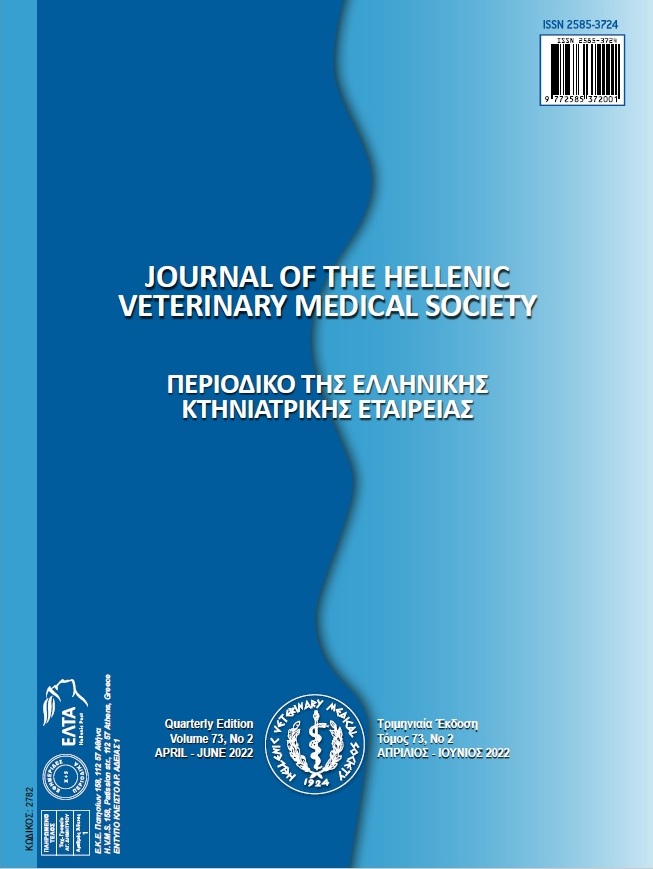A Cross-sectional study on the transmission dynamics of Bovine Herpesvirus-1 infection in the farms located in the Thrace Region of Turkey
Περίληψη
In this study, detection of BHV-1 infections in cattle by using polymerase chain reaction (PCR) and enzyme-linked immunosorbent assay (ELISA) and investigation of the risk factors associated with the spread of the virus within the herd were aimed. Three dairy farms were selected in the Thrace district, Marmara region, Turkey, and two visits to these farms. A questionnaire was prepared for the farmers. On the first visit, 4 (14.81%) of 27 animals on Farm 1, 6 (28.57%) of 21 animals in farm 2, and 3 (7.31%) of 41 animals in Farm 3 were found to be seropositive for BHV-1. On the second visit, 6 (25%) of 24 animals in Farm 1, 6 (35.29%) of 17 animals in Farm 2, and 6 (20%) of 30 animals in Farm 3 were found to be seropositive for BHV-1. Thirteen (14.6%) of 89 blood samples were seropositive at the first sampling and 18 (25.35%) of 71 blood samples in the second sampling. Two calves belonging to 7 cows that were found to be seropositive at the first visit, and the calves of four of 10 mothers found to be seropositive at the second visit were also found seropositive. BHV-1 DNA was detected in only 3 of the 43 milk samples taken during the first and second visits (2 on the first visit, one on the second visit), and 13 of 160 nasal swabs (8 on the first visit, five on the second visit). All the cows with three milk samples whose BHV-1 DNA was detected by PCR were determined as seropositive. Three of the eight cattle with BHV-1 DNA detected in nasal swabs on the first visit, and 4 of the five cattle with BHV-1 DNA detected in nasal swabs on the second visit were detected seropositive by ELISA. The statistical analysis has shown that the association between age, sex, and BHV-1 seropositivity was statistically significant. The BHV-1 seroprevalence was increased in animals on the second visit in all farms. The preventive measurements need to be applied in Turkey to control BHV-1 infections in cattle.
Λεπτομέρειες άρθρου
- Πώς να δημιουργήσετε Αναφορές
-
Ünver Alçay, A., & Yilmaz, H. (2022). A Cross-sectional study on the transmission dynamics of Bovine Herpesvirus-1 infection in the farms located in the Thrace Region of Turkey. Περιοδικό της Ελληνικής Κτηνιατρικής Εταιρείας, 73(2), 4193–4202. https://doi.org/10.12681/jhvms.26963
- Τεύχος
- Τόμ. 73 Αρ. 2 (2022)
- Ενότητα
- Research Articles

Αυτή η εργασία είναι αδειοδοτημένη υπό το CC Αναφορά Δημιουργού – Μη Εμπορική Χρήση 4.0.
Οι συγγραφείς των άρθρων που δημοσιεύονται στο περιοδικό διατηρούν τα δικαιώματα πνευματικής ιδιοκτησίας επί των άρθρων τους, δίνοντας στο περιοδικό το δικαίωμα της πρώτης δημοσίευσης.
Άρθρα που δημοσιεύονται στο περιοδικό διατίθενται με άδεια Creative Commons 4.0 Non Commercial και σύμφωνα με την άδεια μπορούν να χρησιμοποιούνται ελεύθερα, με αναφορά στο/στη συγγραφέα και στην πρώτη δημοσίευση για μη κερδοσκοπικούς σκοπούς.
Οι συγγραφείς μπορούν να καταθέσουν το άρθρο σε ιδρυματικό ή άλλο αποθετήριο ή/και να το δημοσιεύσουν σε άλλη έκδοση, με υποχρεωτική την αναφορά πρώτης δημοσίευσης στο J Hellenic Vet Med Soc
Οι συγγραφείς ενθαρρύνονται να καταθέσουν σε αποθετήριο ή να δημοσιεύσουν την εργασία τους στο διαδίκτυο πριν ή κατά τη διαδικασία υποβολής και αξιολόγησής της.



